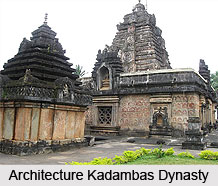 The rise and spread of the famous Kadambas of Banavasi in the south-western Deccan, during the 4th century A.D. is not only a political interesting phenomenon but also as inductive of a sociological trend in South India. The Kadambas of early medieval South India are known to the historians of South India mostly from their inscriptions and occasionally from later literature.
The rise and spread of the famous Kadambas of Banavasi in the south-western Deccan, during the 4th century A.D. is not only a political interesting phenomenon but also as inductive of a sociological trend in South India. The Kadambas of early medieval South India are known to the historians of South India mostly from their inscriptions and occasionally from later literature.
Going beyond their achievement what is more thrilling is their origin two centuries ago. Their name though known through their inscriptions as Kadamba is really only Kadamba. They must be related to the Kadambus mentioned in Tamil Sangam literature of 2nd century A.D. and as a piratical tribe residing in the north-western parts of the Tamil country and decisively defeated on more than one occasion by the great Chera ruler, Imayavaramban and his son Senguttuvan. In fact the Kadhambus of Sangam literature had for their totem the Kadambu tree sacred to Lord Muruga who is himself known as a Kadamba.
The Kadambas of early medieval history also worshiped the Subrahmanya and they bear the same name; and the name of the founder of the line was Mayura (peacock) Sarman. It is believed that in their inscriptions the Kadambas claim to be Brahmins and of the Manavya gotra. It was a practice among early medieval dynasties, though they might belong to non-brahmanical varnas or tribal jatis, to claim descent from Vedic rishis and give brahmanical gotras to themselves. This is part of a process known generally as Sanskritisation and is part of the evolutionary process of gotra-totem mutual influence. An understanding of this broad sociological phenomenon is necessary for the proper identification of the Kadambas.
The history of the Kadambas as understood by modern historians are derived mostly from a pillar inscription known famously as the Talagunda inscription of Kakusthavarman, actually put up by his son Santivarman. This Kakusthavarman was the fifth ruler of that dynasty and he ruled from 425 A.D. to 450 A.D. According to that inscription, the founder of the line Mayura Sarman (called Sarman to establish the fiction of brahmanical origin) (345-60 A.D.) went to Kanchi the capital of the Pallavas to proceed with his Vedic studies, but picked up a quarrel with an equestrian soldier in the Pallava capital and entered a martial career. He defeated the Pallava army in the west and carved out a small principality for himself.
This dynasty had eleven rulers from Mayura Sarman to Krishnavarman whose reign ended in 565 A.D. Among them Santivarman, the son of Kakustavarman, was a great conqueror but he had to face the hostility of the Pallavas. In his times the kingdom was divided into two and the southern districts came under the rule of his younger brother Krishnavarman. This Krishnavarman, however, fought the Pallavas, was defeated and killed in the battle and his son Vishnuvarman became a subordinate ally of the Pallavas, mentioned as Nankkassa and Santivara whose names are not known to us otherwise. Mrigesavarman, the son of Santivarman tried his best to turn the tables on the Pallavas but he could not. His son Ravivarman was more successful than his immediate predecessor and he brought about the re-unification of the Kadamba kingdom. His successor Harivarman (538-550 A.D.) was a contemporary of Pulakesin I; the Chalukyawho founded his kingdom in 545 A.D. in Vatapi. Kirthivarman, the son of Pulakesin I conquered the Kadamba kingdom in about 565 A.D. The Kadamba power survived till the 10th century until they were absorbed by Vijayanagar Empire.



















